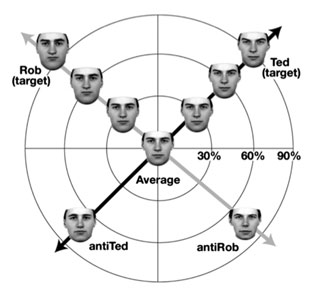THIS ARTICLE IS MORE THAN FIVE YEARS OLD
This article is more than five years old. Autism research — and science in general — is constantly evolving, so older articles may contain information or theories that have been reevaluated since their original publication date.

Face memory: People with autism are less likely than controls to be influenced in their impressions of facial features.
Family members of individuals with autism process faces and scenes differently than do controls, according to two new studies1, 2, one of them published in October. The results suggest that visual processing may be an autism endophenotype — a measurable symptom that represents part of the genetic risk of a disorder.
Relatives of individuals with autism tend to have some features of the disorder, a condition called the broad autism phenotype. These traits may be linked to certain genetic risk factors.
In the first new study, published in the 2012 issue of Autism Research Treatment, researchers showed clips from four children’s television showsto 22 children with autism and 46 controls, all aged 1 to 6 years, and their parents. The researchers followed the participants’ gaze using eye-tracking technology.
The children with autism were diagnosed using the Autism Diagnostic Observation Schedule and the Diagnostic and Statistical Manual of Mental Disorders IV.
For each video, the researchers calculated regions of interest — the areas at which people tend to look most often. For example, one video shows an animated grandma rabbit playing with baby rabbits in her living room while objects such as a school bus appear in the window.
Children with autism are less likely than controls to look at the rabbits’ faces or the vehicles going by, the study found. Those who have more severe symptoms spend even less time looking at these areas than those who have mild symptoms. The researchers did not find statistically significant differences in the response to the other three videos.
Mothers of children with autism are less likely than mothers of controls to watch the regions of interest in three of the four videos. Interestingly, fathers of children with autism watch the videos just like control fathers do.
The results suggest that the broad autism phenotype may present differently in women than in men, the researchers say.
In the second study, published in the October issue of Neuropsychologia, researchers investigated a potential mechanism underlying face recognition. Studies suggest that people average the features that they see regularly to represent a typical face. They then recognize individuals based on variation from this norm.
For example, if people are shown a series of photographs of faces with large eyes, they are more likely to think, when shown a photo of an average face, that this face has unusually small eyes. Children with autism are known to be less susceptible to this effect3, which may explain their difficulty in recognizing faces.
In the new study, the researchers introduced the relatives of 14 children with autism and 13 controls to pictures of two policemen, called Rob and Ted. They also created two faces, ‘antiRob’ and ‘antiTed,’ with features that are the opposite of Rob’s and Ted’s, respectively. For example, Rob has a large mouth whereas antiRob has a small one. They also created a neutral face averaged from the faces of 20 men.
The researchers showed the participants a series of ‘burglars’ with either antiRob or antiTed faces. They then showed the participants a policeman with the average face and asked whether this policeman was Rob or Ted.
The controls tend to think the policeman is Rob when the burglars are antiRob, and that he is Ted when the burglars are antiTed. This tendency is weaker in both parents and siblings of children with autism than in controls, the study found.
References:
1: Groen W.B. et al. Autism Res. Treat. 2012, 748467 (2012) PubMed
2: Fiorentini C. et al. Neuropsychologia 50, 2926-2932 (2012) PubMed
3: Pellicano E. et al. Curr. Biol. 17, 1508-1512 (2007) PubMed
By joining the discussion, you agree to our privacy policy.